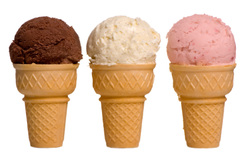
_“Like it or not, Starbucks has changed expectations of how coffee should taste.”
Bruce Horovitz (USA Today, 2006)
Starbucks over roasts their coffee, they should be called ‘Charbucks.’
Anonymous R & D comment
Coffee aroma contains powerful antioxidants.
UC Davis Study

_4. Butter Melts Down
This texture property of melting is a huge reason why butter is so pleasurable; this is yet another tasty food with high dynamic contrast. People will not prefer butter substitutes that don’t meltdown in the mouth. I know; in my food science days, I was asked to create a shelf stable whipped topping–the project was a success–but the concoction would not melt in the mouth and was rejected by the taste panelists. Margarine substitutes taste best when they perfectly mimic the meltdown properties of butter.

_2. Butter Is High in Fat
The mouth has the ability to sense fat (perhaps two separate taste mechanisms), and its presence lights up the brain in a pleasure response. This has been confirmed for ice cream. Butter has the same butterfat structure, although it is much lower in sugar.

_“Often overlooked, though, is the fact that butter is a ready-made sauce base.”
(Thomas Keller1)
“Hunger is the best sauce in the world.”
((Cervantes (1547–1616))

__7. Ice Cream Contains Casomorphins
The major milk protein in ice cream is casein, and upon digestion it creates morphine-like molecules called casomorphins. Some scientists believe these compounds can make food more addicting.8,9 These molecules may also affect pain sensitivity, locomotion, anxiety, and learning.10 In addition, Lin et al. (1998), note that fat ingestion, through its action on enterostatin (a peptide released by the gut upon fat digestion), reduces fat reward by actions on mu-opioids.

__5. Ice Cream Is Loaded with Salt, Fat, and Sugar
The “big three” are very pleasurable ingredients, and ice cream has them in abundance. The typical fat content of premium Häagen-Dazs is approximately 16 percent butterfat (by weight), the salt content is about 0.5 to 1.0 percent, and the remaining ingredients being sugar and protein.

_2. Ice Cream Is Cold
Another dynamic contrast component to food is the change in oral temperature. The mouth is loaded with trigeminal receptors for both heat and cold, but cold may be a greater stimulator of sensory sensation. Cold perception in the mouth is a huge trigeminal blast, and when the food warms up again, it produces dynamic contrast and increases food pleasure.

_Ice-cream eating is fun and fires up brain's pleasure center. Every ingestion brings back one’s childhood memories. Adam Drewnowski (nutrition and sensory expert) speculated that there might be a relationship between opioid addiction and ice-cream craving. Americans love ice cream, and, next to the Australians, consume more of it than people from any other country. The twenty billion dollar ice cream industry is dominated by Nestlé and Unilever, although there are over five hundred regional mom-and-pop shops that make and distribute America’s favorite dessert (or treat).

_3. Oreos Allow for an Optional Eating Pattern
Personalizing the eating experience increases food pleasure. Many people manipulate the cookie before ingestion. Your personality may be based on how you eat an Oreo. Men tend to bite through the cookie, and women tend to pull apart the cookie and eat the filling first.

_Studies on snack foods suggest a narcotic-like effect on the brain.
“Food and Sin are two words that––in the English-speaking world, anyway––have long been linked.”
(Anthony Broudain)
The Oreo cookie is a standard fixture in many a household pantry, including mine, as my daughter has a fondness for the “mini” ones.












 RSS Feed
RSS Feed